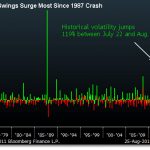Welcome to the ?Heads I win, tails you lose? market. The prospect of imminent quantitative easing by the US, Europe, China, and even Japan is supporting asset prices globally. The worse the economic data reports, the greater the likelihood of such action, and the higher prices can rise. In this topsy turvey world, bad becomes good, and worse is even better.
The only reason for the central banks not to act is if the economy starts to reaccelerate on its own without outside intervention. So the choices presented to investors are really quite limited: you either buy, or you buy. This is the twisted logic that has allowed traders to run the markets up to within 2% of the four year highs on incredibly small volume.
There is only one problem with this approach to the market. It requires mental gymnastics that would earn a gold medal at the London Olympics.
The harsh reality is that this impressive gain in the market has occurred in the face of decidedly deteriorating fundamentals. American companies managed to eke out a 5% gain in earnings in Q2, down from a 15% increase a year ago. Adjust for inflation and this growth rate approaches zero in real terms.
What is particularly disturbing is that they achieved these scanty results in the face of falling revenues. They did this by cutting costs, primarily through the firing of workers. This is why the unemployment rate remains at a stubbornly high 8.3%, despite some of the most impressive stimulus measures in history. Companies are burning the candle at both ends to gin up extremely modest positive results. They are literally eating their seed corn.
Needless to say, this does not support any kind of thesis for long term investment. All it does is move us from the bottom to the top of a six month range. I can?t imagine that you are going to see many aggressive buyers higher than here. Edge up from here, and you might witness the disgusting sight of traders throwing up on their shoes as they rush to cover premature shorts.
That is when you want to hold your nose and establish your shorts. Even the most bullish forecasts have the S&P 500 going up only 5% from here to 1,475, before it heads back down again.
This is not the first time that the market action has divorced itself from the fundamentals. I watched the Japanese stock market go from strength to strength for ten years before it knocked itself out crashing into the ceiling at ?39,000. Last night it closed at ?8,978, some 22 years later. Those analysts at Morgan Stanley obsessed with fundamentals only during the 1980?s saw their offices moved next to the elevator, then the men?s bathroom, the one with the big punching bag hanging from the ceiling, and finally, out of the building completely.
At this point you have to ask how much of QE3 is already priced into the market. If the Federal Reserve instituted this aggressive monetary expansion policy two months ago, they might have been able to engineer a 200 point move in the (SPX) or 2,000 points in the Dow. If they do it today, they might get only 50 (SPX) points, 500 Dow points, and perhaps none at all, followed by a sharp drop.
Lighten up your book, take short-term profits, sell short-dated-out-of- the-money calls, and meaningfully reduce your risk. Find something else to trade besides stocks. That is unless you have the luxury of staying out completely. The traders who don?t remember to sit down when the music stops playing will get burned badly.
Don?t Ask Me How I Got Here







